Opening Opportunities: A Comprehensive Guide to the L1 Visa Process
The L1 visa process presents an essential path for international firms looking for to transfer essential employees across boundaries. Understanding the nuances of qualification requirements, the distinctions in between L-1A and L-1B visas, and the details of the application procedure can greatly affect an applicant's success. However, navigating this complicated landscape is not without its challenges, and careful interest to documentation and employer sponsorship is essential. As we discover the vital components of this process, the strategies for getting over potential barriers will become obvious, disclosing just how educated prep work can open a globe of possibilities.
Recognizing the L1 Visa
Understanding the L1 visa requires identifying its relevance as a crucial tool for multinational firms seeking to transfer skilled staff members in between worldwide offices. This non-immigrant visa classification assists in the movement of executives, managers, and specialized expertise employees to the USA, thus enabling companies to preserve functional connection and harness worldwide skill effectively. The L1 visa is split right into two key classifications: L-1A for supervisors and executives, and L-1B for workers possessing specialized knowledge.The L1 visa serves a crucial duty in improving a firm's one-upmanship in the worldwide marketplace - L1 Visa. By permitting firms to relocate their vital workers, businesses can assure that critical tasks are handled by certified people who are already aware of the business's society and functional processes. This internal transfer mechanism not just cultivates expertise sharing but likewise advertises advancement and cooperation throughout borders.Moreover, the L1 visa is often preferred for its fairly straightforward application procedure compared to various other visa classifications, as it allows for double intent, permitting owners to seek irreversible residency while on a short-lived copyright. This feature makes the L1 visa especially appealing for both companies and employees, as it streamlines the path for knowledgeable professionals to develop long-term residency in the USA
Qualification Requirements
Eligibility for the L1 visa rests on numerous crucial requirements that assure both the worker and the company satisfy specific credentials. This non-immigrant visa is created for multinational companies to move employees from foreign workplaces to U.S. counterparts.Firstly, the employer must be a qualifying company, which includes a moms and dad company, branch, associate, or subsidiary of an U.S. service. The firm needs to have been doing organization for at the very least one year both in the united state and abroad. This guarantees that the firm has enough functional stability and a legit presence.Secondly, the staff member should hold a supervisory, exec, or specialized expertise placement. For L1A visas, the applicant must demonstrate supervisory or executive qualifications, while L1B visas concentrate on specialized expertise related to the company's items, solutions, or procedures. Additionally, the staff member must have benefited the foreign entity for at least one continual year within the last three years before their application.Lastly, the worker's function in the U.S. have to align with their previous placement, guaranteeing that their skills and proficiency are leveraged for the company's benefit.
Kinds Of L1 Visas
The L1 visa classification makes up 2 main types made to help with the transfer of workers within international firms: the L1A visa for supervisors and executives, and the L1B visa for staff members with specialized expertise. Each kind serves unique functions and has details qualification criteria.The L1A visa is customized for people that hold managerial or executive placements within a business. This visa allows top-level workers to move to a united state branch, subsidiary, or affiliate of the exact same company. Applicants for the L1A visa have to show that they have been utilized in a managerial or executive capability for a minimum of one continual year within the previous 3 years before their application. In addition, this visa uses a much longer period of keep, originally given for three years, with the possibility of extensions for as much as 7 years.In comparison, the L1B visa is intended for specialists with specialized knowledge associated to the business's products, solutions, or processes. To certify, applicants have to confirm that their expertise is crucial to the organization which they have actually benefited a minimum of one constant year within the last 3 years in a function that required this specialized knowledge. The L1B visa is initially given for 3 years, with extensions available for as much as 5 years.Both visa types are essential for business seeking to improve their global procedures by leveraging knowledgeable personnel, therefore promoting technology and effectiveness within the U.S. market.
Application Process
Guiding via the L1 copyright process includes a number of crucial actions that have to be diligently followed to ensure a successful end result. The procedure starts with the U.S. employer, that have to first establish eligibility by showing a qualifying relationship with the foreign entity and confirming that the staff member meets the certain demands for the L1 visa category being sought.Once eligibility is validated, the employer launches the procedure by submitting Form I-129, the Request for a Nonimmigrant Worker, with the U.S. Citizenship and Migration Provider (USCIS) This type needs to be accompanied by a thorough description of the task tasks to be executed, the organizational framework of both the united state and international entities, and the employee's credentials. It's essential to confirm that all information is exact and complete, as noninclusions or inaccuracies can bring about delays or denials.Upon approval of the I-129 petition, the next action entails the employee looking for the L1 visa at an U.S. consular office or consulate in their home nation. This stage calls for the conclusion of Form DS-160, the Online Nonimmigrant copyright, and arranging a meeting. During the interview, the candidate must offer proof supporting their qualifications and the company's petition.After the visa is approved, the staff member can enter the USA to function in the designated role. On the whole, careful prep work and adherence to every action of the application procedure are important for an effective L1 visa outcome.
Required Paperwork

Necessary Kinds Required
Maneuvering the L1 Visa procedure needs cautious focus to the vital types and paperwork required for a successful application. The key form required is the Type I-129, Petition for a Nonimmigrant Employee, which must be finished and sent by the U.S. employer. This type lays out the details of the work deal and the certifications of the worker looking for the L1 Visa.Alongside Kind I-129, the candidate will certainly require to full Kind I-539 if going along with member of the family are also looking for visas. In addition, the employer must give proof of the certifying partnership between the united state entity and the international entity, typically requiring the entry of corporate files such as write-ups of unification or monetary statements.Moreover, it is important to include the L Classification Supplement to Type I-129, which specifies the kind of L Visa being requested-- either L-1A for managers and executives or L-1B for staff members with specialized expertise. Applicants ought to assure that all types are authorized and dated suitably, as incomplete entries can lead to delays or denials. Effectively constructing these crucial types lays the foundation for a smoother L1 copyright process.

Sustaining Proof Needs
Supporting documentation is vital for a successful L1 copyright, as it corroborates the cases made in the request. Candidates should provide a series of papers to demonstrate qualification for the visa, which is categorized right into two key kinds: proof of the qualifying partnership between the united state and international entities and evidence of the candidate's qualifications.To develop the partnership, candidates need to submit documents such as business organizational graphes, monetary declarations, and proof of ownership. These documents validate that the foreign company has a qualifying partnership with the U.S. company, whether as a parent business, subsidiary, branch, or affiliate.For the candidate's credentials, important documents consist of a comprehensive work letter from the international company, outlining the applicant's work title, responsibilities, and period of employment. Furthermore, academic qualifications, such as degrees and diplomas, must be offered to prove the applicant's knowledge in the appropriate field.
Company Sponsorship Papers

Typical Obstacles
Navigating the L1 visa procedure provides numerous common challenges that candidates must be aware of. Secret concerns typically include rigid paperwork requirements, prospective delays in handling times, and the necessity for stringent legal compliance. Recognizing these barriers can aid applicants better prepare and alleviate threats throughout their copyright journey.
Paperwork Needs
The L1 copyright procedure usually provides significant obstacles associated with documents demands. Applicants have to provide comprehensive paperwork to develop qualification, which can bring about complication and prospective delays. Key papers consist of proof of a certifying connection in between the U.S. and international employer, evidence of the applicant's work history, and in-depth information about the task role in the U.S.One usual obstacle is collecting adequate proof to demonstrate the nature of the qualifying connection. Companies often struggle to existing clear business graphes or monetary declarations that highlight the link between the entities. On top of that, guaranteeing that letters of assistance from employers precisely mirror the candidate's work obligations and qualifications is necessary, as unclear descriptions can lead to denials.Another concern arises from the requirement for in-depth task summaries that align with the L1 visa categories. Applicants have to articulate not only their present duty however likewise their managerial or specific knowledge duties clearly. This requires a thorough understanding of both the applicant's setting and the regulatory L1 Visa process language used in L1 applications.
Processing Dead Time
Experiencing hold-ups in processing times is an usual obstacle faced by L1 visa applicants, usually causing irritation and unpredictability. Numerous elements add to these delays, including high application volumes, enhanced analysis of applications, and administrative stockpiles within the U.S. Citizenship and Immigration Solutions (USCIS) Applicants may locate that handling times can differ significantly depending on the solution center managing their application, as each facility has its own workload and efficiency degrees. Furthermore, the intricacy of the applicant's situation, such as the requirement for substantial documents or clarification, can additionally extend wait times.In some instances, concerns associated with the candidate's existing immigration condition or previous visa history might additionally lead to added delays, as USCIS might call for additional review or information. It is necessary for candidates to continue to be aggressive during this duration, maintaining open communication with their companies and legal reps to attend to any type of potential problems promptly.Understanding these handling time obstacles can help L1 visa applicants prepare for feasible hold-ups and reduce the effect on their change and occupation strategies. Patience and diligence are essential merits in steering this detailed procedure.
Lawful Conformity Issues
Numerous L1 visa candidates encounter legal conformity problems that can complicate their journey towards getting the visa. Recognizing and sticking to the details laws set by the U.S. Citizenship and Migration Solutions (USCIS) is essential. Typical challenges consist of demonstrating the qualifying connection in between the international and U.S. companies, in addition to confirming that the candidate possesses the requisite customized knowledge or supervisory capacity.Additionally, candidates should offer complete documentation outlining their work tasks, business framework, and financial feasibility of the united state entity. Inadequate or imprecise documentation can bring about hold-ups and even rejections. Employers need to likewise assure that they conform with labor regulations, including wage and functioning problem requirements, which can impact visa eligibility.Another common issue entails keeping compliance with the regards to the visa once provided. Modifications in work standing, task obligations, or company structure can necessitate modifications to the visa, which if not dealt with quickly can cause legal problems. As an outcome, staying educated about compliance needs and seeking lawful advice when needed is important to browse the complexities of the L1 visa procedure efficiently.
Tips for Success
Success in the L1 copyright procedure commonly pivots on careful prep work and focus to information. To boost your chances of authorization, start by extensively recognizing the eligibility requirements for both the L1A and L1B visa groups. Review whether your position at the business qualifies as managerial, exec, or specialized knowledge, as this classification significantly impacts your application.Next, collect comprehensive documentation that validates your claims. This includes organizational graphes, detailed work descriptions, and proof of the business's functional structure. Clear and succinct proof of the qualifying relationship between the united state entity and the international entity is essential. Verify that all records are arranged practically and provided in a professional way, as this reflects your dedication and severity about the application.Engage the services of a knowledgeable migration lawyer that focuses on L1 visas. Their knowledge can prove vital, leading you via complicated regulations and ensuring that all paperwork follows present laws. In addition, plan for the meeting by exercising solutions to common concerns and being ready to discuss your role and contributions to the company in depth.
Regularly Asked Questions
Can Household Members Come With the L1 Visa Owner?
Yes, family members of L1 visa holders, including partners and single children under 21, can accompany the primary visa owner. They may likewise request L2 visas, which enable them to reside in the USA.
Exactly How Long Can I Remain On an L1 Visa?
The L1 visa enables preliminary remains of up to 3 years, with the possibility of extension. L1A visa holders may stay for an optimum of seven years, while L1B visa holders can continue to be for five years.
Can L1 Visa Owners Get a copyright?
Yes, L1 visa owners can apply for an environment-friendly card. L1 Visa. They might go after long-term residency with employment-based categories, normally needing sponsorship from their company, given they meet the needed credentials and documents needs
What Happens if My L1 copyright Is Refuted?
If your L1 copyright is denied, you might get a notice outlining the reasons for rejection. You can look for to appeal the decision, reapply, or check out alternate visa options based upon your conditions.
Are There Any Type Of Travel Limitations With an L1 Visa?
An L1 visa usually enables global traveling; however, re-entry to the U. L1 Visa Requirements.S. rests upon keeping legitimate condition. Tourists ought to ensure conformity with visa problems to avoid problems upon return
Final thought
